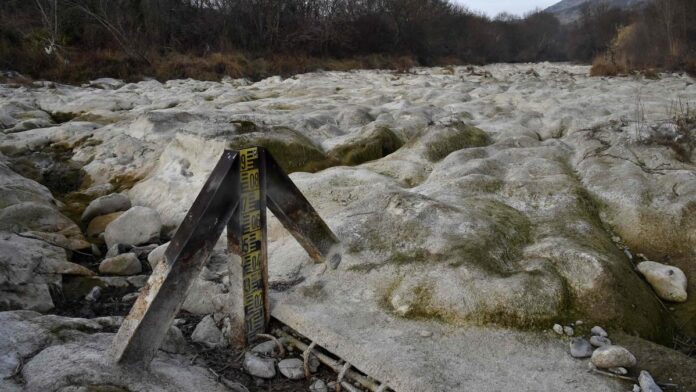
‘There are serious limitations in our knowledge about the volume, flux and quality of water in lakes, rivers, soils and aquifers’
| Photo Credit: AFP
The World Water Conference that was convened by the United Nations (March 22-24 2023) was the first UN conference on freshwater in almost 50 years. It was held in the context of serious environmental issues — flooding, drought, a severity of climate change and a looming food crisis. The conference also marked a mid-term review of the Water Action Decade 2018-2028 (to advance the water agenda by energising existing programmes and projects, and inspiring water action to achieve the 2030 Agenda, in particular Sustainable Development Goal 6 (SDG 6), which envisages the sustainable management of water and sanitation for all.
The central outcome of the conference was the international Water Action Agenda, to which governments, multilateral institutions, businesses, and non-governmental organisations submitted over 670 commitments to address water security issues. Nearly 164 governments and 75 multilateral organisations have made commitments. While the commitments embodied in the Water Action Agenda are voluntary and, therefore, legally non-binding, the voluntary commitments are expected to inspire the collective political will, which is needed to address the many water challenges.
Poor finances, poor water services
The commitments made at the conference must be scrutinised to see whether they will yield universal, safe, affordable and equitable access to water that is consistent with SDG 6. Meeting this target by 2030 (as envisioned by the SDG) will incur capital expenditures of $114 billion per year. The World Bank estimates recurring operations and maintenance for basic water and sanitation service (WASH) costs to rise from about $4 billion to over $30 billion per year by 2030, which is far more than the capital costs for basic WASH services. The World Resources Institute (WRI) is of the view that the commitments made by the states reflected rigour, scope, and ambition but they lacked proper finance and targets that are quantifiable in nature. Investment of this range would require valuing water, which in turn requires robust water measurement and accounting. There are ‘serious limitations in our knowledge about the volume, flux and quality of water in lakes, rivers, soils and aquifers. There are huge gaps in water usage data. The metering of water has triggered resistance from India to Ireland because of concerns about equitable access and affordability of water services’.
Funding from regional, national, and international sources prioritises new water infrastructure rather than on water maintenance services (World Bank study). It results in decreased service for water customers. World Bank estimates project recurring operations and maintenance service (WASH) costs to rise from about $4 billion to over $30 billion per year by 2030, which is far more than the capital costs for basic WASH services. Water does not qualify to be a global public goods as it is not considered to be an area of urgent funding as compared to climate change. The Global Environment Facility (GEF) is the only international funding mechanism that has been able to cover more than 300 watersheds and an even greater number of aquifers across the political boundaries of two or more states with its grant and concessional loan.
India at the conference
India’s commitments at the conference were: an investment of $240 billion in the water sector and efforts to restore groundwater level. A 2021 CAG report says that groundwater extraction in India increased from 58% to 63% between 2004-17. This has been further exacerbated by climate change resulting in intermittent rainfall, which further undermines the recharge potential.
The revised Groundwater Bill 2017 vests State groundwater boards with creating laws, managing water allocation and other relevant issues. The State boards are understaffed, and lack in expertise and prioritising socio-political conflicts over groundwater resources.
In international law, ‘states possess the authority to make voluntary commitments to address issues of global concern. These commitments are distinguished from other legal forms because they are not made pursuant to a consensus instrument to which the parties have agreed. They are generally independent of the commitments of other parties’.
Efforts to ‘tackle climate change and to promote environmental sustainability have led states to make voluntary commitments to curb greenhouse gases and to take measures to promote sustainability, even in the absence of a legally non-binding instrument. The commitments of states after the Climate Conference in Denmark (December 2009), underline this. But in the case of climate change, these voluntary commitments take place within a broader context of binding agreements: the United Nations Framework Convention on Climate Change, the Kyoto Protocol, and the Paris Agreement’.
The 2023 Water Conference takes place within the context of SDG 6, and not within the context of the UN Water Convention 1997 and the United Nations Economic Commission for Europe (UNECE) Water Convention 1992, the two legally binding legal instruments on regulation of trans-boundary river water courses. But the target embodied in 6.5 of the SDG 6 focusing on ‘implementation of integrated water resources management (IWRM) at all levels, including through transboundary cooperation as appropriate’ is a common thread between the Water Conference and the two conventions.
Voluntary commitments are becoming an important feature in the environmental law vista, but they raise difficult issues of accountability. Commitments made by the states with different formats and with different content pose challenges in terms of monitoring compliance with each commitment. Voluntary commitments are perhaps just a necessary step in the face of inaction.
Anwar Sadat is a Senior Assistant Professor in international law, specialising in environmental law, at the Indian Society of International Law, New Delhi
#takeaways #World #Water #Conference
